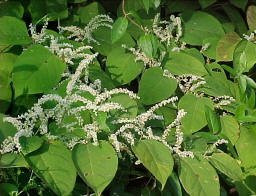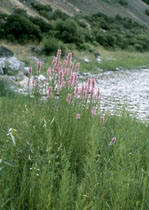Frank
Williams
Adams County
Master Gardener

Invasive species
(plants, insects, and animals) have been
a part of the American landscape for
decades. But their spread in recent
years has been truly monumental
including virtually all sections of the
country. This article stems from a
contact I had with a friend in Adams
County at whose home I observed massive
amounts of English ivy invading his
wonderfully wooded property and climbing
even large trees in the area. Today we
will deal only with those invasives
which take over landscapes.
What is an
Invasive Plant?
Basically, an
invasive plant is one which can thrive
and spread aggressively, often outside
its natural range and under a wide
variety of environmental conditions.
Those that colonize in a new area have
an ecological advantage since the
insects, diseases and foraging animals
which control them in their natural
range may not be present to the same
degree in a new environment.
Some Typical
Examples
|

Japanese knotweed
Polygonum cuspidatum
|

Purple Loosestrife
Lythrum salicaria |
The English ivy
mentioned above is but one of a number
of invasive plant varieties which
frequent our area. Some other prime
examples include exotic honeysuckle,
crown vetch, Japanese knotweed,
mile-a-minute, and purple loosestrife.
All share the ability to establish
themselves easily, spread quickly, and
strangle other desirable native
indigenous plants over time.
Consider the
Damage
As mentioned
above, invasive plants can disrupt, or
even destroy, natural habitats.
Sensitive ecosystems such as sand dunes
and wetlands are especially vulnerable.
In areas such as national parks, even
visitor foot traffic can create a void
and become quickly invaded. Purple
loosestrife, for example, can be
observed where folks have created
footsteps in the damp ground. Native
plants and trees destroyed by the
invasives may take hold again as an
invasive groundcover prevents new
germination. In Montgomery, Maryland, a
group of volunteers called Weed Warriors
have been enlisted to do battle in an
effort to identify and remove or destroy
invasive plants. Now here is a "war" we
can all support!
In your own
yard, think of the damage that English
ivy and other vines can do, not only
your plants, but also to masonry,
gutters and any place where roots can
grow and take hold.
What Can You Do?
In an article
published in the Old House Journal,
Kathleen Fisher writes about "whacking
wicked weeds." In essence, she advises
that homeowners get rid of them by
cleaning the yard totally of invasives,
cutting them back and removing remaining
debris off the home’s facing and around
desirable plants.
From the United
States National Arboretum, I found some
other suggestions in the August, 2004
release as follows:
- Check with
your local resources (Pennsylvania
State Extension Service, Master
Gardeners) With respect to which
plants are invasives, learn how to
identify them;
- When making
landscaping plants, use only
non-invasive plants in the development
of that plan;
- Be especially
careful when landscaping your property
if it borders on open, local, state,
or national park areas;
- Use
herbicides carefully as a last resort
to remove invasive plants in a way
that does not do damage to native
plants or other desirable plants in
your landscape;
- Make others
in your neighborhood aware of invasive
plants and how to identify, remove, or
control them.
Summary
If you have some
invasives in your yard (as I do with
English ivy), take measures to remove or
manage them carefully. Our ivy, for
example, grows over a patio fence with a
pleasing, cascading effect. But regular
manicuring and serious cutting away the
overgrowth was absolutely essential
during this wet spring and summer. You
can help your yard and environment by
becoming aware of the problem and
assisting others to deal with it. Be
pro-active in this crusade. The
invasives are indeed here and becoming
more aggressive each year.
Read other articles on ecological gardening & native plants